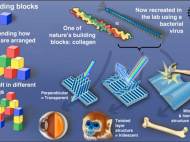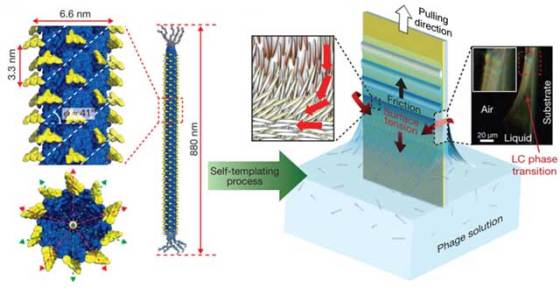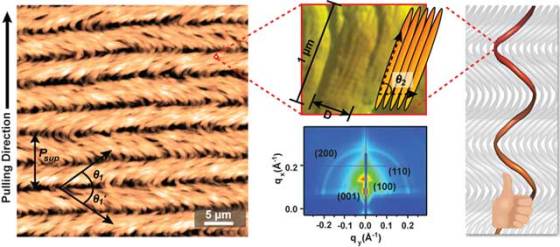Biomimetic self-templating supramolecular structures
 A team consisting out of researchers from the Lawrence Berkeley National Laboratory and University of California, Berkeley, has discovered a method to create artificial materials with desired properties by controlling the assembly of these complex structures. To achieve this effect, the researchers used bacteriophage as the building block which mimicked the ability of natural tissues to self-assemble from cellular proteins.
A team consisting out of researchers from the Lawrence Berkeley National Laboratory and University of California, Berkeley, has discovered a method to create artificial materials with desired properties by controlling the assembly of these complex structures. To achieve this effect, the researchers used bacteriophage as the building block which mimicked the ability of natural tissues to self-assemble from cellular proteins.
In nature, a single macromolecule can form diverse functional structures when self-assembled under different conditions. For example, Collagen type I forms different type o of tissues depending on their local function in a tissue. In transparent corneal tissues it forms orthogonally aligned fibers, in distinctively colored skin tissues it forms regularly interspaced fiber bundles, and in mineralized tissues it forms hierarchically organized fibers to form the tissue.
Since our current understanding of this process is still not well explored and understood, the researchers from Berkeley decided to mimic the process by using rod-shaped M13 bacteriophage which has structural similarities to collagen.
The process where they grew desired structures starts with immersion of a glass substrate in a solution with dispersed bacteriophage building blocks with controlled pulling process from the substrate. By precisely controlling the pulling process, the building blocks were carried to the surface (meniscus line) of the solution. This allows the water on the exposed surface of glass substrate to evaporate and the resulting liquid-crystalline structures were imprinted on the substrate.
Berkeley researchers used this single-step process to produce supramolecular films with long-range order and multiple levels of hierarchical organization and helical twist. As a demonstration, they created three distinct supramolecular structures (nematic orthogonal twists, cholesteric helical ribbons, and smectic helicoidal nanofilaments) by adjusting the concentration of viruses in the solution and the speed with which the glass was pulled.
Both liquid-crystalline phase transitions and competing interfacial forces at the meniscus line where the deposition takes place were found to be critical factors in determining the morphology of the imprinted structures during assembly.
Grazing-incidence small-angle x-ray scattering (GISAXS) measurements conducted on ALS Beamline 7.3.3 revealed the pseudo-hexagonal packed structure of the liquid-crystalline phage films. The resulting materials showed distinctive optical and photonic properties, and the M13 bacteriophages with genetically incorporated bioactive peptide ligands were able to grow as both soft and hard tissue in a hierarchically organized manner.
Further development and tuning of synthetic self-templating systems could enable the development of advanced structural, optical, and biomedical materials, including sophisticated functional helical-twisted structures.
For more information, read the article published in the journal Nature: “Biomimetic self-templating supramolecular structures”.











Leave your response!